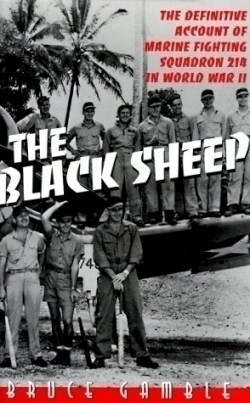Black Sheep
The Definitive Account of Marine Flying Squadron 214 in World War II
In a historical context, society and its collective memory consumes wars by the mouthful, in big gulps, and tends to remember them by their cumulative titles: The Franco-Prussian War or World War II. We are, at times, unable to recall that wars are made up of the long daisy-chain of individual days—of small comings and goings of individual men and women.
Black Sheep is a war account that narrates this simple fact so brilliantly. First-time author Bruce Gamble has written a gem—an outstanding work of popular revisionist history.
Cunningly, Gamble takes us to the days of the squadron’s inception during those dark and nervous days just after the attack on Pearl Harbor. We begin to feel a bit like George Britt, the squadron’s first commander, as he anxiously attempts to build a Marine air squadron out of whole cloth: no pilots, no planes, no plan (other than to kick the Japanese back to Tokyo somehow, someday).
Here is where the work really shines. While the idea-germ for the book may have been to set the record straight about Commander Greg “Pappy” Boyington and his record as a Marine air ace, Gamble first takes us to the Solomon Islands in the shoes of young hotshot pilots, and nudges us to experience the squalid conditions of islands so newly liberated that their airstrips still reek from the stench of the unburied dead. He lets us revel with the airmen while they gobble up shore leave in the sumptuous luxury of Sydney in the 1940s. And he clues us in to dozens of little-known tidbits: like the fact that the landing gear on the legendary Corsair was very unpredictable and that it could be “blown” down with a puff from an emergency carbon dioxide canister. These details bring the experience of the war into the day-to-day and here-and-now.
The Black Sheep is marvelously written. Humor and dialog, as they must have been during the actual fighting, are always present, but Gamble keeps it tight and understated. This is real history, perfect for the lay historian. Gamble stated his goal in writing the book was to preserve the honest, living memory of individual men and women who lived and fought in the war, and to bring their experiences to life in the after years of the World War II generation. He succeeds in spades.
Reviewed by
John Arens
Disclosure: This article is not an endorsement, but a review. The publisher of this book provided free copies of the book to have their book reviewed by a professional reviewer. No fee was paid by the publisher for this review. Foreword Reviews only recommends books that we love. Foreword Magazine, Inc. is disclosing this in accordance with the Federal Trade Commission’s 16 CFR, Part 255.

